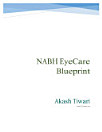Accreditation Readiness Aligning Local Healthcare with Global Standards
ਇਸ ਈ-ਕਿਤਾਬ ਬਾਰੇ
The book delves into various tracer activities, such as individual patient tracers, system tracers (e.g., infection control, medication management), and department-specific tracers (e.g., operating theaters, endoscopy, hemodialysis). These tracers help assessors evaluate the integration and coordination of care across different departments and services. The guide also emphasizes the importance of leadership interviews, where hospital leaders discuss their approach to quality improvement, patient safety, and strategic goals.
Key areas covered include facility management and safety, medication management, infection prevention, and healthcare information technology. The book provides practical advice on preparing for accreditation surveys, including organizing meetings, reviewing policies, and ensuring staff are trained and knowledgeable about accreditation standards. It also stresses the importance of patient interviews to gauge the quality of care from the patient's perspective.
The guide concludes with a focus on continuous quality improvement, urging hospitals to develop robust measurement plans, monitor performance indicators, and implement sustainable improvements. By following the outlined steps, healthcare organizations can achieve accreditation, enhance patient safety, and improve overall care quality, ensuring they meet both global standards and local healthcare needs.
ਲੇਖਕ ਬਾਰੇ
Akash Tiwari (AT) - (PGD - IIM,Indore, MBA- Operations & HR, BSc - Nursing, LLB, AI in Healthcare- Stanford) is a seasoned healthcare leader with over 20 years of expertise in operations, Nursing, quality management, and service excellence. An IIM Indore alumnus, he has led Apollo Hospitals, Ahmedabad, to achieve JCI accreditation three times with zero non-conformities and audited 35+ hospitals for JCI/NABH compliance. Currently, as Corporate Head of Operations Process Excellence at Dr. Agarwal's Eye Hospital, Akash drives operational efficiency and innovation, including AI integration and process optimization. With roles like CEO of Siddhi Vinayak Hospital and Group Head of Quality at Shalby Limited, he combines strategic leadership with a passion for education, teaching healthcare management at Ahmedabad Management Association. Connect with Akash to explore healthcare transformation collaborations.
LinkedIN ID: linkedin.com/in/akashtiwari5








